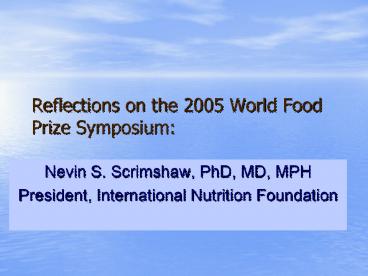Reflections on the 2005 World Food Prize Symposium: - PowerPoint PPT Presentation
Title:
Reflections on the 2005 World Food Prize Symposium:
Description:
Title: Slide 1 Author: Dr. Scrimshaw Last modified by: Alicea Murra Created Date: 10/8/2005 3:22:26 PM Document presentation format: On-screen Show (4:3) – PowerPoint PPT presentation
Number of Views:65
Avg rating:3.0/5.0
Title: Reflections on the 2005 World Food Prize Symposium:
1
Reflections on the 2005 World Food Prize
Symposium
- Nevin S. Scrimshaw, PhD, MD, MPH
- President, International Nutrition Foundation
2
THE LIFE CYCLE APPROACH TO NUTRITION AND FOOD
NEEDS
- At the moment of conception nearly everyone has
the genotype for a long and healthy life. - From the this time onward environmental factors
damage this potential to produce a far different
phenotype than at conception. - Malnutrition and overnutrition are the most
common and consistent factors responsible, for
this damage.
3
The Life Cycle Approach Involves Nutrition at All
Ages
- Pregnant lactating women
- Infant toddler
- School child adolescents
- Adults at all ages
- Women of child bearing age
4
Pregnancy
- Folic acid deficiency in early pregnancy
increases neural tube defects. - Iodine deficiency impairs fetal brain
development - Protein-energy deficiency lowers birthweight with
multiple consequences. - Iron deficiency lowers infant iron stores at
birth. - .
5
Infancy
- When breast milk is no longer sufficient,
appropriate complementary feeding is essential or
physical and mental stunting results. - Iron deficiency and protein-calorie malnutrition
are the main risks.
6
Lactation/Infant Feeding
- Breast feeding provides only half the daily iron
required in infancy the balance must come from
the stores at birth - These are exhausted by about 6 months, by 4
months if mother is anemic, by 2 months for low
birth weight infants. - Without supplementation or iron fortified food
permanent impairment of myelenation of cranial
nerves and dopamine neurons inevitable when
stores at birth are exhausted.
7
Toddler/Pre-school Child
- PEM can permanently reduce physical and mental
development. - Vitamin D deficiency leads to rickets.
- Iron deficiency anemia causes reduced cognitive
and motor performance.
8
School child and adolescent
- PEM affects physical growth and behavior.
- Iron deficiency impairs school performance.
- Vitamin D deficiency leads to rickets.
- Low calcium intakes predispose to adult
osteoporosis
9
Adult
- Poor diet and life style lead to the early
development of - Diabetes type II
- Hypertension
- Heart disease
- Increased susceptibility to cancer
- Less resistance to infection
10
Elderly Adult
- Partially preventable declines in
- Physical strength (sarcopenia)
- Cognitive function and dementia
- Mobility and independence
- Partially preventable increases in
- Malignancies
- Infections
- Dependency
11
Still neglectedWomen of Child-bearing Age
- Women must enter pregnancy with adequate folic
acid status to avoid fetal neural tube defects - Iron supplementation during pregnancy is too
late! - Good weight gain is essential to normal infant
birth weight.
12
Examples of Destructive Non Nutritional Factors
- Use of Tobacco
- Use of Narcotics
- Alcohol Medication Abuse
- Trauma
- Heavy metal poisoning lead, arsenic fluoride
- Radiation
13
New insights into global hunger
- Agronomic Characteristics and Nutritional Value
- Overt Hunger and Hidden Hunger
- Nutritional Deficiency and Nutritional Excesses
- The triple burden of Nutritional Disease
- (Due to Fetal Origins of Adult Disease)
14
Challenges to Agriculturists
- Plant breeding
- Improve protein quality
- Improve beta carotene content
- Improve availability of non-heme iron
- Animal husbandry
- Lower proportion of total fat
- More healthful fatty acid composition
15
Challenges to the Nutritionists
- By developing international consensus
- priorities to avoid waste of financial and
human resources due to conflicting or poor
nutritional advice to agriculturists. - Be advocates for maximizing the qualitative as
well as quantitative contributions of agriculture
to feeding the human population.
16
Dont depend on any one solution!
- Protein quality can be assured from genetically
improved cereals such as QPM or by legumes or oil
seed protein to complement a cereal staple or by
adding animal protein to the diet. - Vitamin A activity can come from the beta
carotene of yellow vegetables and be enhanced by
genetic engineering as well as animals. - B vitamins and minerals can be provided cheaply
and effectively by universal multiple
fortification of the cereal staple so that
breeding for them may not be worthwhile.
17
Conclusions
- Target the process, not just the
problem Mainstreaming in development, PRSPs - Challenge the invisibility of
malnutrition forgotten emergencies, hidden
hunger, - Address all aspects (lifecycle) of malnutrition
Wasting, stunting, micronutrients, obesity - Protect investments against shocks Multiple
inputs, links with all MDGs - Legislated empowerment (rights)
- Meeting demand requires funds for nutrition
18
Thank you
- Thank you































